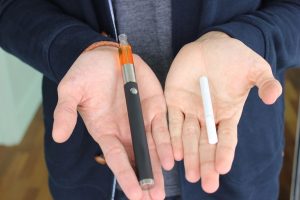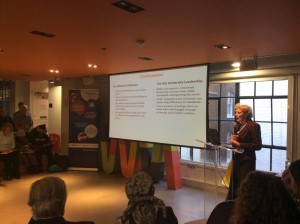by Meg Fluharty @MegEliz_
This blog originally appeared on the Mental Elf site on 17th February 2016.
Women have twice the risk of developing major depression compared to men. This difference is most noticeable during the reproductive period years (Soares et al, 2008) (e.g. premenstrual, during pregnancy and postpartum, and perimenopause) when women are subject to large fluctuations of ovarian hormones.
Additionally, oestrogens are believed to utilise neuroprotective and antidepressive actions within the the brain (Arevalo et al, 2015), and transitioning to the postmenopausal period is associated with a large drop in oestrogen production (Burger al al., 2007).
Therefore, the authors, Georgakis et al (2016), are using ‘age at menopause’ and ‘duration of reproductive age’ as two markers of lifelong oestrogen exposure to measure the association with risk of depression in postmenopausal women.

Research shows that the median age for final menstrual period is 52.5 years, and that 90% of women have their final period by the age of 56.
Methods
Search criteria
The authors conducted a search in MEDLINE using the following keywords: menopause, climacteric, reproductive period, depression, and mood disorders. The authors then searched reference lists of included studies to identify additional studies. There was no restriction on language, publication year or study design. Cross sectional and cohort studies were obviously going to be helpful, but randomised controlled trials were also considered for eligibility if they included depression measurements before intervention.
Definition of variables
- Age of menopause was defined as 1 year following last menstruation (although studies examining age at final menstruation were also considered)
- Duration of reproductive period was defined as age of menopause minus age of menarche
- Diagnosis of depression was defined by clinical diagnosis or validated questionnaire
Excluded studies
Studies were excluded if they used questionnaires without defined cut-offs, or self-reported depression as a single question. Studies including only women with depression were excluded as were those which also had severe psychiatric disorders. Case series, case reports, in vitro and animal studies were excluded. Studies limited to perimenopausal (the period leading up to menopause) women, breast cancer survivors with medically induced menopause, or women with surgically induced menopausal transition were excluded.
Statistical analysis
The odds ratios (OR) and confidence intervals (CI) were pooled across the identified studies, and the analysis was conducted separately for the two exposure variables (age of menopause and duration of reproductive period). The variables were first analysed as continuous variables in 2 year increments, and age of menopause was analysed again as a categorical variables (≥40 vs <40).
Results
A total of 67,714 women were included across 10 cross sectional and 4 cohort studies.
- 12 studies used self-report diagnosis of depression
- 1 study used DSM-III-R diagnosis
- 1 study used physician diagnosis.
Women without a diagnosis of depression were used as the control group.
Age at menopause
Pooling the effect estimates across 13 studies which treated age at menopause as a continuous variable (e.g. 2 year increments); increased age of menopause was associated with 2% decrease in risk of postmenopausal depression (OR, 0.98; 95% CI 0.96 to 0.99 heterogeneity I2=7.6%; P=.37). Sensitivity analyses for hormone therapy, premenopausal depression, or defining age at menopause as 1 year following last menstruation did alter the association.
In 4 studies with data on premature menopause (<40 years), twice the risk of depression was found compared to women with menopause onset over 40 years (OR, 0.49; 95% CI 0.29 to 0.81; heterogeneity I2=54.2%, p=.09).
Reproductive period
Pooling the effect estimates across 5 studies that includes reproductive period as a continuous variable (e.g. 2 year incriminates); found similar associations to age at menopause: a 2% decrease in risk of postmenopausal depression for an increase in reproductive period of 2 years (OR, 0.98; 95% CI 0.94 to 1.01; heterogeneity I2=0.0%; P=.41).

This evidence suggests that women who have the menopause later in life, are less likely to experience depression in their postmenopausal years.
Discussion
This meta-analysis displayed an inverse relationship between the age of menopause and subsequent risk of postmenopausal depression, which prevailed after controlling for hormone therapy and premenopausal depression. Additionally, a similar effect was found within an analysis of the duration of reproductive period. These findings indicate that shorter exposure to endogenous oestrogen is associated with oestrogen deficiency and consequently heightened risk of depression after menopause.
To put it another way, the longer the period between menarche (first menses) and menopause (defined as final menstrual period or 1 year after final menstrual period), the lower the risk that the woman will experience depression in her postmenopausal years.
If these findings are confirmed within culturally diverse studies, they can be used to identify at-risk women for postmenopausal depression whom may benefit from either psychological monitoring or oestrogen-based therapy (Georgakis et al 2016).
Strengths and limitations
This systematic review featured a well-conducted meta-analysis, including a total of 67,714 women across 14 studies; and took important confounders into consideration (age, obesity, hormone therapy, smoking, and marital status). The authors conducted sensitivity analyses where necessary and there was no evidence of publication bias in the ‘age at menopause’ studies.
However, there were some limitations to consider:
- Limiting their literature search just to the MEDLINE database will have resulted in many trials been missed, which is clearly a big weakness for any systematic review.
- 12 of the 14 included studies used a self-report diagnosis of depression, rather than a diagnosis reached by a validated diagnostic instrument.
- There were differences in the definition of depression, and depression cut-offs across studies.
- The association of pre-existing depression and hormone therapy use on later depression should be considered; however the authors did conduct sensitivity analyses where possible.
Many women report a huge lack of information about the menopause, fuelled by a continuing stigma relating to this ubiquitous part of female human existence. This study provides some important pointers to risk factors and later life mental illness, which could be used to help educate women about their risk of depression as they age. However, given the limitations of this current review, we should look for further confirmation of these findings before we consider this question well and truly answered.

Do you talk to your female friends about the menopause?
Links
Primary paper
Georgakis MK, Thomopoulos TP, Diamantaras A, et al. (2015) Association of Age at Menopause and Duration of Reproductive Period With Depression After Menopause: A Systematic Review and Meta-analysis. JAMA Psychiatry. Published online January 06, 2016. doi:10.1001/jamapsychiatry.2015.2653. [Abstract]
Other references
Soares CN, Zitek B. (2008) Reproductive hormone sensitivity and risk for depression across the female life cycle: a continuum of vulnerability? J Psychiatry Neurosci. 2008;33(4):331-343.
Arevalo MA, Azcoitia I, Garcia-Segura LM. (2015) The neuroprotective actions of oestradiol and oestrogen receptors. Nat Rev Neurosci. 2015;16(1): 17-29. [PubMed abstract]
Burger HG, Hale GE, Robertson DM, Dennerstein L. (2007) A review of hormonal changes during the menopausal transition: focus on findings from the Melbourne Women’s Midlife Health Project. Hum Reprod Update. 2007;13(6):559-565. [PubMed abstract]
If you’re looking for a good overview of recent evidence-based research, please read the Evidently Cochrane blogs on the Menopause.
Photo credits
– See more at: http://www.nationalelfservice.net/mental-health/depression/later-menopause-linked-with-lower-risk-of-depression/#sthash.v4Zbt9Fx.dpuf



 Traumatic brain injury is the leading cause of death and disability among children and young adults worldwide.
Traumatic brain injury is the leading cause of death and disability among children and young adults worldwide. This review highlights a lack of RCTs that explore the potential value of medication for cognitive impairment following traumatic brain injury.
This review highlights a lack of RCTs that explore the potential value of medication for cognitive impairment following traumatic brain injury.